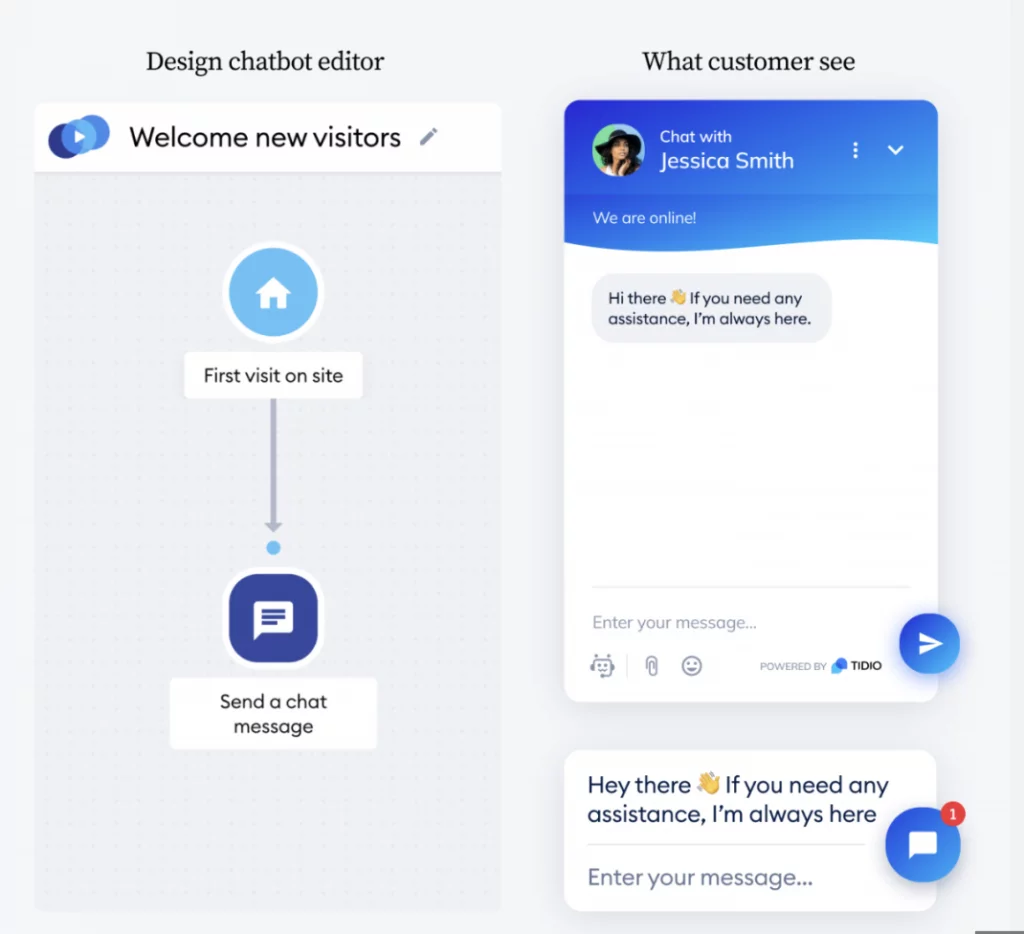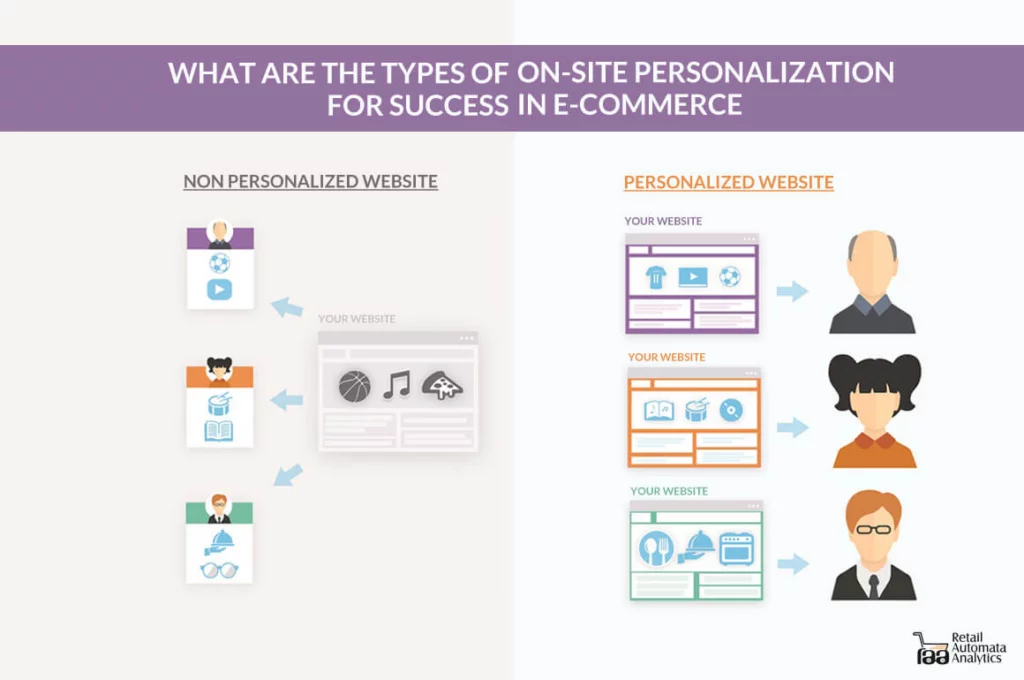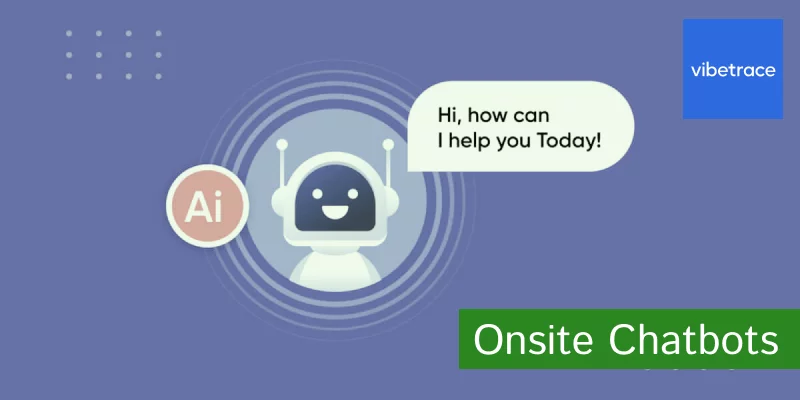With the advent of the internet, companies have more sales channels to play with than ever before. Maybe a Facebook page or other social media channel has become a part of your marketing strategy.
Perhaps you’re thinking of taking this further and integrating a messenger bot into your sales technique.
Even for an ecommerce business, who are so often at the forefront of digital innovation, chatbots can drive customers away in droves.
So without further ado, let’s dive in.
What is a chatbot?
A chatbot – also known as a bot, messenger bot, or AI chatbot – is software designed to recreate human interactions over the internet. It works through APIs (application programming interfaces), connecting users to brands through either established messaging platforms like WhatsApp and Kik, or built into individual sites.
It’s also lauded as a type of artificial intelligence – though rather than working from machine learning principles, it is essentially just programmed to answer specific questions. We’ll get into that in more depth a bit later on.
These messenger apps have become especially prevalent as online shopping has become the norm. Everyone from startups to Sephora seem to be encouraging their customers to use chatbots on Kik and Facebook to interact with their online store.

Brands can use them to automate a step in the customer journey, and they’re a step in the direction of conversational commerce. But are they all they’re cracked up to be?
Should ecommerce stores be using chatbots?
At its core, the problem with chatbots is that you have a human messaging a machine. Neither really has the capability to understand the other, and exasperation ensues – at least on the human end.
So is it enough, when considering using chatbots, to accept them blindly, only stopping to wonder which type you should invest in?
But we’d suggest that using automated messaging apps in this way could not just not improve your business – it could actively harm it.

And when businesses are jumping on Shopify or Facebook messenger chatbots left and right, might the path to standing out be to avoid following the crowd?
We can think of plenty of reasons to not invest in chatbots: here are six just off the top of our heads.
Chatbots don’t enhance the customer experience
It’s pretty easy to get swept up in the hype around ecommerce chatbots. They purport to be speedier, more efficient, and, crucially, cheaper than their counterparts.
It’s true that they’re fairly simple to set up: Facebook Messenger and Amazon’s Alexa both have the function ready and waiting.
But in boasting of their efficacy and their speed, proponents of AI chatbots often leave out a key detail: they’re just not that good.
It’s doubtless that you have a list of business processes streamlined—in which case, look into how to make your business processes more efficient.
But automation doesn’t always mean efficiency – as is the case with chatbots. Did you know that 32% of customers would walk away from a brand after just one bad experience with them?

Customer experience is a cornerstone of brand strategy: 73% of potential customers said it hugely impacted their purchasing decisions.
That’s especially pertinent for online businesses, who need to capture that in-store experience without actually having a bricks-and-mortar store.
Online conference platforms improve human customer support channels, and marketing and CRM teams are often fighting to keep customers happy and interested from the very first moment they discover the brand to when they make a sale.
They send abandoned cart emails. They carefully monitor the conversion rate of campaigns. They answer – as carefully as they can – customer queries.
Why do all this? Because they’re trying to keep customers hooked and retention rates high. Brand loyalty can be fickle – one wrong move or frustrating experience and your potential customer has fled to a competitor.
So why are ecommerce companies falling back on using ecommerce chatbots that don’t enhance the customer experience at all – and in some cases even detract from it?
There’s no real personalisation
As the ecommerce world becomes more crowded and competition between retailers hots up, one of the key ways to stand out is through personalisation – and it’s an area in which chatbots fall woefully short.
Perhaps it stands out more in the user experience because messenger bots are touted as so human-like, yet completely lack the empathy to make that ring true.
Sure, chatbots can ask for your name – though that feels intrusive and somehow manipulative. You know they’re only asking to increase the appearance of personalisation – and maybe to collect data about you.
There’s a similar problem with any utterances of “sorry”. You know that this bot isn’t sorry – it can’t be sorry, doesn’t understand the concept of sorry, and moreover, doesn’t comprehend your frustration at all – rendering its “sorry” meaningless.
The importance of personalisation in ecommerce
The truth is, using your name is only a fraction of the personalisation that matters. Ideally, a company should know much more: style choices, typical budgets, big anniversary dates.
Capgemini found that 64% of online users would be happy to hand over personal information – if it meant getting an enhanced customer experience.
They also point towards a trend of hyper-personalisation, which not only segments customers into groups but responds to them as individuals. Customers’ needs might pivot between traditional segments over the course of a day, a month, or whether it’s a workday or weekend, for example.
AI chatbots just can’t keep up with this level of personalisation, and their attempts at creating a connection often fall short.
Messenger chatbots on platforms like Facebook messenger and Alexa are particularly egregious in this respect: because of the increased security concerns, it’s likely that companies using them won’t be able to give the bots access to any information that actually matters.

Your past orders, or returns statuses, for example. Banking details beyond basics like the branch opening hours – which can be found with a quick Google search.
This is why technology like an interactive voice response system can make such a difference when interacting with customers, and why chatbots need an equivalent to be able to even keep up.
Even on a more basic level, customers often look for personalised product recommendations and deals – which can be sent via email or even SMS – but chatbots are almost universally able to offer nothing of the sort.
Trust and the human touch
From opinions on self-driving cars to eerie Westworld-like SciFi on our screens, the simple truth is that people just don’t trust chatbots or technology in general.
There is a general mistrust of technology that pretends to be human whilst veering into uncanny valley-levels of just missing that mark.
The mistrust of ecommerce chatbots goes further than that, though.
It might surprise you how much consumers are interested in the human element of the customer experience: 75% actually wanted more human contact, even as they increasingly move online for their shopping.
A chatbot’s inability to interpret human emotions and phrases is just one of the ways it comes off as thoroughly impersonal.
The importance of human agents
One trade that hasn’t yet embraced the technology of chatbots – and for good reason – is the hair industry.
Bear with us for a moment – we know hair salons are in-person and not ecommerce ventures. But really, they’re not that different: you can look up prices and portfolios online, and make an appointment through online booking systems. You have to go to the salon to actually receive the service, but that’s just logistics.
By the time you’re in the salon, the business has already closed the sale. In many cases, you’ve already paid at least a deposit.
So why does it seem absurd to think of hairdressers using chatbots to discover before your arrival what you want – and then snipping hair off as soon as you sit down in the chair? It would certainly save them time – which means more customers through the door and more revenue.
Obviously, in this situation we want to communicate with a real human: hair is individual, it is unique. Dye colours depend on skin tone. Perhaps most crucially, humans have the ability to interpret vagueness.
Most hairdressers will be able to translate that into a straight cut with honey-gold highlights – even if they have to ask for reference pictures.
But a chatbot?
A chatbot pigeonholes you into a response – before you get the opinion of an expert, which is what you want when you enter a salon.
How that translates to ecommerce
It’s that industry expertise – from someone who can understand your concerns even if they’re strangely articulated – that’s entirely missing from the chatbot experience.
Would you really invest in a VoIP service after just a few cursory questions? Or would you prefer to talk to a company representative to see how this software could work specifically for you and your company’s needs?
If we have questions or concerns – especially when it comes to big purchases – most of us would prefer to chat to a real, live human, whether that’s in person or through an online meeting.
Unnervingly, messenger bots also tend not to use natural language and phrases, instead coming off as stiff with scripted, unhelpful responses – because that’s all they have to fall back on. So not only is your interaction fruitless but it also leaves you feeling as if you’ve gone around in circles and only ever talked to a machine.
They’re nothing more than interactive FAQs
An AI chatbot essentially isn’t artificial intelligence at all – at least not in the way that matters. They don’t learn from interactions and grow bolder, more intelligent, more human – the hallmark of AI. They’re stuck following a pre-programmed script – and they don’t have the answers if you deviate from it.
You have to know exactly which common questions and phrases trigger the answer you’re looking for – assuming the messenger bot is even equipped to answer that question in the first place.
It’s essentially no more efficient than a comprehensive FAQs section. Arguably, these are also less frustrating, as customers can easily locate the section that’s most likely to contain what they need.
If they don’t find it, then they can call a helpline or send an email – both hopefully manned by customer experience executives who have the ability to understand what you’re asking and respond with useful information.
Chatbots are just an extension of customer support
This failure of ecommerce chatbots isn’t an anomaly in customer support – even when human agents are involved.
Have you ever had to go through a rather monotonous conversation with someone where it was obvious they were just following a checklist – and very few of the questions were even on the topic you called about in the first place?
Or sent an email to a company only to have them copy and paste a generic non-answer as a reply?
Almost inevitably, you leave the call or email thread no more enlightened as to the answer to your query – and rather irritated. Your opinion of the company as a whole might even decrease.
It’s like they want to wind us up.
FAQs vs. actual customer support
On the whole, interactive FAQs are probably the best way an ecommerce business can use a chatbot. But they aren’t just being employed to answer individual queries. Some businesses try to use them to replace human assistants – which can lead to a serious disconnect.
When you interact with a human, you get emotions and opinions and expertise – not to mention access to workarounds of problems you might be experiencing.
Say you’ve seen a holiday advertised: three nights in Cuba at an all-inclusive hotel. Sounds good, but you’d prefer to spend five nights away – and you need to make sure that the hotel serves gluten-free options.
Chatting to a travel rep means in this situation that they would likely rearrange the flights to suit you, liaise with the hotel restaurant about dietary options, and suggest suitable alternative accommodation if gluten-free just wasn’t an option.
The interaction is seamless, fuss-free – and you get a holiday booked in no time, even if it’s not what originally caught your eye. But via a messenger chatbot? You’d likely go through loops of questioning the menu and just being directed to the hotel website – if that.
Sales is an art form that chatbots have not mastered
Have you ever met an uber pushy salesperson? One who won’t let you browse without interjecting, asking what you’re after and trying to upsell at every opportunity?
Thankfully, many businesses are moving away from this model – salespeople have become beacons of expertise. They’re there to question if you need assistance, but they don’t try to have you sign away your right leg for that product you must have right now or risk living without it forever.
Do you like this article?
Join our CX for Retail dedicated newsletter!

Stay connected to what’s really important to optimize your digital revenues.
By clicking the button, you accept our Terms & Conditions. Also you will need to confirm your email address.
They build up a rapport – especially when it comes to SaaS companies, whose clients will be working with them after purchase.
It’s only after you’re satisfied with the product offered, as well as comfortable around the employee and the brand, that you sign on the dotted line – or even give away more than your name.
Chatbots, on the other hand, are pushy. What little personalisation they can attempt comes in the form of fairly invasive questions early on: often, you’ll find that the first two questions they ask will be your full name and email address.
This forces customers to commit before they’ve even voiced their questions. Who wants to sign up to an email list that way? Endless emails await – until they end up in junk, of course.
Besides, a good salesperson will at least pretend to be enthusiastic about the field. A great one? Well, they’re the ones chattering about the sector on their days off as well.
That enthusiasm is far more infectious and downright compelling than an emotionless interface. A well-timed joke or instance of relatability might be the difference between making a sale and not.
Did you know that Aristotle is sometimes lauded as the first great salesman? Sales is a process that has been going on since 7BCE and, despite stereotypes, it’s a delicate art. It revolves entirely around communication – reading cues and knowing how to respond to them to put the potential customer at ease.
Impressive though chatbot technology is – especially when compared to Aristotle’s era – it just can’t outcompete a good old fashioned human sales-closer.
There are better alternatives to chatbots
None of this is to say that there aren’t aspects of businesses that don’t benefit from automation – or even robotic integration.
If you want to get techy – and we highly recommend embracing it – there are a variety of ways you can use innovative technology to make your ecommerce customer experience better, and oftentimes save money in the process.
If you’re going to have a pop-up on your page, for example, at least make it a useful one. Imagine the frustration of your customers when a helpful-looking chatbot pings up in the corner of their screen – then takes them around in circles and doesn’t tell them anything new or valuable about the brand.
In contrast, there is onsite technology like our Digital Assistant that targets all the problem issues for chatbots – and provides the right kind of customer experience.
You can use them to create a guided selling experience, leading potential customers to products and services that work for them, rather than generic options. They can create and send deals at the right time – ie. when the customer is actually looking to spend money.
You can even use them to collect and collate customer data, making the experience more personalised as the customer uses the site and interacts with the brand.
This kind of in-store experience online is what chatbots shoot for: the idea is that they can answer questions and point you in the right direction in real-time, just like an in-store employee. But sadly, they fall short – leaving users feeling irritable and less likely to make a purchase.
Looking at another aspect of business, there are plenty of instances in which robotic process automation (RPA) can help to streamline your organisation. They can take on monotonous tasks and leave human employees to more creative or complicated endeavours.
Automatic call distribution is yet another way in which automation – and indeed, set scripts – can benefit companies, at least, when they’re used correctly.
These scripts can be used to parse callers into categories so that when the human agent gets to them they are already equipped with some knowledge about the call’s topic. In larger businesses, this might even mean being passed onto the relevant customer service team.

